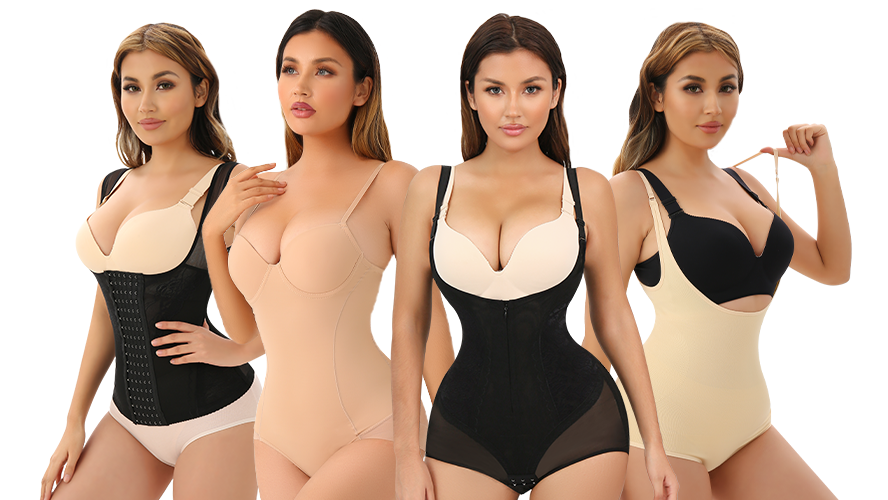Recent years have witnessed an emergence of shapewear as an attractive market for entrepreneurs, with global sales estimated at $2.26 billion in 2018 and projected to hit $3.8 billion by 2025 – showing immense opportunities for growth and success in this space. This guide is written for individuals captivated by the idea of starting their own shapewear business but don’t know where to start; whether newcomers to fashion industry or experienced apparel entrepreneurs looking for expansion opportunities; it provides insights and steps needed for launchling this venture successfully.
Understanding the Shapewear Market
Definition of Shapewear
Shapewear (commonly referred to as foundation garments) are pieces of clothing intended to temporarily alter one’s body shape to produce a more streamlined or defined figure. Their main goal is providing an effortless silhouette while simultaneously increasing confidence and comfort levels of their wearers. Be it bodysuit, waist cincher, or control briefs; shapewear works to enhance and support natural body shapes by offering support where necessary.
Trends and Statistics on Market Performance
The shapewear market has experienced steady growth, due to evolving fashion trends and increased awareness about body positivity and comfort. Here are some key trends and statistics:
1. Market Growth: In 2018 alone, the global shapewear market size was valued at $2.26 billion and projected to reach $3.8 billion by 2025, growing at an expected compound annual compound annual growth rate of 7.7% from 2019-2025.
2. E-Commerce Boom: E-commerce platforms have made shapewear accessible to more people, contributing significantly to market growth; many consumers prefer online sales over visiting retail locations for their purchases.
3. Innovations in Fabric and Design: Market leaders are consistently developing innovative fabrics and designs to meet consumer needs, such as seamless styles made of breathable material or featuring seamless techniques that add appeal.
4. Men’s Shapewear Market: While women remain the primary purchasers, there has been an emerging market for men’s shapewear to meet men’s desire for sleeker bodies.
Target Audience Analysis
Understanding your target audience is crucial for the success of any shapewear business. Here are some steps for conducting an audience analysis:
1. Demographics: Get to know your potential customers’ ages, genders, income levels and any other relevant aspects.
2. Understand their preferences: Do your research to gain an understanding of your target audience’s preferences when it comes to style, comfort and price.
3. Buying Behavior: Conduct an in-depth evaluation of the buying behaviors of your target audience, such as where they shop, the frequency with which they purchase shapewear and any factors which influence their purchasing decisions.
4. Competitor Analysis: When conducting competitor analysis, look carefully at their target audiences to identify any gaps or unmet needs that you can fill with your business offerings.
5. Market Surveys and Feedback: Conduct market surveys or collect customer feedback in order to better understand customer needs and expectations.
By understanding the shapewear market, its trends, and target audience you are creating an excellent foundation for your shapewear business. Your knowledge will assist in making informed decisions as you advance with further steps of starting up your company.
As we progress with this section, we will dive deep into the planning stage of your shapewear business, covering different business models, financial planning strategies and legal compliance measures to help ensure an easy start-up journey.
Planning Your Shapewear Business
Business Model Options
Establishing the ideal business model for your shapewear venture is of vital importance as it forms the basis of how it will function and generate revenue. There are various models you should take into account for this decision:
Under this model, shapewear manufacturers provide discounted bulk purchases to be sold as markup products to your customers. This business strategy works best if you have physical retail space or an established online store and requires significant upfront investments but offers greater control over pricing, branding and profit margins.
On the other hand, dropshipping provides an effective entryway for those starting with limited capital. In this model, suppliers ship products directly to your customers without your involvement; while it requires less upfront investment and gives less control over branding and customer experience.
Private label models allow you to develop your own shapewear brand by working closely with manufacturers. This model allows for unique brand identification within the market; working directly with them, you would work together on designing, branding and packaging your products while offering something special and different to customers. However, this requires substantial investments; but can result in higher profit margins and customer loyalty.
Financial Planning
A sound financial strategy is at the core of every successful shapewear business plan. An estimate should be created of the initial investments necessary for stock, marketing, and operational expenses as well as creating a budget to guide spending decisions and manage cash flow effectively.
Exploring funding options is essential if the initial investment exceeds your financial capacity, whether through loans, grants, venture capitalist investments, crowdfunding campaigns or pre-sales campaigns. If they fit, these can also serve to validate demand while raising funds simultaneously.
Legal Compliance and Licensing
Maintaining legal compliance and obtaining necessary licenses are paramount to running a legitimate shapewear business. Begin by registering your business with relevant governmental bodies and selecting an appropriate business structure such as sole proprietorship, LLC or corporation as each may carry with it unique legal and tax implications.
Trademarking your brand, logo and designs will provide your business with protection from intellectual property infringement, which is particularly essential in the fashion industry.
Recognizing your tax obligations – such as sales tax, income tax and import/export duties – is also crucial. Establishing an accurate record-keeping system and timely tax filing will help avoid legal complications in the future.
Finding the Right Shapewear Manufacturer
Starting a brand new business is exciting. But if you want your shapewear store to be sustainable and successful, finding a reliable shapewear supplier is very important. Next we will discuss how to complete this critical step:
Understanding the Value of Reliable Manufacturers
The supplier you choose will be directly responsible for the production and supply of your shapewear products. This means that they will directly determine how your customers feel about your product. And a stable shaping wear supplier will make your cooperation smoother and save a lot of potential time and problems. Reliable suppliers ensure consistent quality and timely delivery while becoming a valuable partner in growing your business.
Researching Potential Manufacturers
Begin your search by conducting extensive research. Focus on finding manufacturers with experience producing shapewear or similar garments; trade shows, industry directories and B2B platforms can all serve as starting points. In addition, connect with industry peers or join apparel manufacturing forums online to seek recommendations.
Evaluating Manufacturers Once you have identified several potential manufacturers, it’s time to evaluate them according to various criteria:
Quality of Products: Gather samples to assess the quality of materials, stitching, and finishes before ordering from any potential manufacturers. Minimum Order Quantities (MOQs): Some manufacturers require large MOQs which might not fit with your initial budget and scale requirements; select one with MOQs that align with these constraints instead.
Pricing: Cost should not be the only deciding factor when budgeting and pricing your products.
Communicating: Effective communication between yourself and your manufacturer is crucial; make sure they respond promptly, welcome feedback, and are clear when communicating their messages to you.
Lead Times: Knowing how long it will take the manufacturer to produce and ship your order will be essential in managing inventory costs and meeting customer demands.
Visit Manufacturing Facility For Further Inquires
If possible, visit the manufacturing facility directly. This allows you to see first-hand how production takes place, assess working conditions and form relationships with manufacturers directly – it may provide valuable insights that remote communication cannot.
Negotiating Terms and Forming an Alliance
Once you’ve identified a manufacturer, it is time to negotiate terms. Discuss pricing, payment terms, lead times, and any other specifics. Keep in mind this could be an ongoing relationship so building mutual trust will help lead to successful partnerships.
After You Start Working With A Manufacturer
Regular evaluation of your supplier is key in order to make sure you remain aligned with a manufacturer that can meet all your business needs as they evolve. Be sure to assess product quality, delivery timelines, relationship factors and overall relationship as you assess these areas regularly so as to stay ahead of evolving business needs.
Find a shapewear manufacturer is a process that requires diligence, patience, and an attentive eye. By choosing one who shares your business values and quality standards, you set yourself up to offer products your customers will trust and love.
Product Selection and Branding
Selecting the Appropriate Shapewear Products
As the market for shapewear products is expansive and diverse, selecting products that resonate with both your target audience and stand out in the market can be daunting task. When beginning a new business venture it is key that product selections resonate with both parties involved – consumers and vendors.
Start by understanding all of the different kinds of shapewear available – from bodysuits and waist cinchers to control briefs and thigh shapers – each type serving its own specific function for smoothing out silhouettes, accentuating particular body parts or providing post-surgical support.
Keep this in mind when starting up. In general, it may be more effective to focus on offering only high-quality and in-demand products rather than spreading yourself too thin.
Building a Unique Brand Identity
In the fiercely competitive shapewear world, quality products are paramount – but it is your brand that can set you apart. Brand is more than a logo or tagline; it evokes emotions in customers that drive business decisions.
1. Brand Story: Begin by outlining your brand story. Why did you start this business, what values and beliefs drive its direction, etc. A compelling brand story can establish an emotional bond with your target market and encourage customer retention.
2. Visual Identity: Your visual identity comprises your logo, color palette, typography and overall design aesthetics. Make sure that it remains consistent across platforms like websites and social media as well as packaging and promotional materials.
3. Voice and Tone: From product descriptions on your website to social media posts or customer service interactions, having a consistent voice and tone across all communications is key. Decide whether your brand has formal, playful, inspirational, or educational overtones before aligning all communications accordingly.
4. Packaging: Packaging can make an important impression upon customers when shopping online, whether that means luxury goods, eco-friendliness or minimalism. Invest in high-quality branded packaging that aligns with your brand values – whether that is luxury goods, eco-friendliness or minimalism.
5. Positioning: Understand where your brand stands within the market – luxury or budget friendly option? Your positioning can have an enormous effect on pricing strategies, marketing approaches and manufacturers you work with.
Product selection and branding are interdependent processes, with your selections having an effect on how customers perceive your brand while your branding identity informs which products align with it. By giving both processes equal importance, you ensure your shapewear business not only provides in-demand products but also creates memorable customer experiences that foster loyalty and advocacy from its clients.
Marketing and Promotion
Today’s digital realm can be complex. To succeed in shapewear-specific marketing is to navigate its subtleties efficiently; let us begin this exploration together! Let us discover all its secrets of promotion: let’s go on an in-depth journey together into its depths!
Digital Marketing Strategies.
1. Website and SEO: In an increasingly digital landscape, websites serve as beacons leading potential clients toward your brand. Providing an engaging user experience through mobile-optimized visuals and concise language descriptions is of key importance; while investing in SEO helps ensure its brightness increases further – drawing clients quickly towards you!
2. Social Media Marketing: Platforms such as Instagram, Facebook and Pinterest don’t merely serve as digital arenas – they serve as bustling bazaars full of life! For shapewear brands it is crucial to tell their narrative using imagery of product features or heartwarming customer accounts; engaging quickly with digital users via targeted posts or custom advertisements can increase brand resonance & increase the potential audience reach of your brand story.
3. Email Marketing: Fostering an email community can be like building a cozy fire. With regular newsletters that include exclusive offers, product releases or educative material like shapewear styling advice or discourse on body positivity – regular communications such as these can foster a feeling of connection among subscribers and build their sense of belongingness and encourage participation.
4. Content Marketing: Add wisdom and expertise to your website with content such as “Navigating the Shapewear Terrain” or “The Empowerment of Adorning Shapewear”, not only positioning yourself as an industry thought leader, but bolstering digital presence of brand.
Offline marketing strategies
1. Pop-Up Shops: Leveraging temporary retail spaces or joining forces with traditional shops for pop-up ventures can be an invaluable strategy, not only expanding market reach but also giving a real-time pulse on consumer sentiment analysis.
2. Collaborative Ventures and Alliances: Engaging with brands or influencers who share your ethos can reap great dividends; for instance, featuring your shapewear in an active fitness hub could introduce it to new enthusiasts and expand sales channels.
3. Local Advertising: Grassroots advertising remains alluring – be it billboards, radio spots or sponsoring local galas; all are great ways of placing your brand firmly within a community’s fabric and further embedding itself with that community’s fabric.
Marketing and promotion are ever-evolving practices. Businesses must navigate the digital environment delicately while crafting strategies to capture new aficionados while building long-term brand loyalists.
Conclusion
Entrepreneurial adventures of every sort present themselves when starting a shapewear business – opportunities, challenges, and immense rewards all add up in this adventure! As this guide illustrates, success in this venture requires more than having great products alone. Understanding your market, making educated decisions and creating an iconic brand while engaging with your target market are keys to establishing success in any endeavor. Be it manufacturing processes, crafting an irresistibly appealing brand identity or exploring various sales channels – each step towards developing a shapewear brand which stands out and connects with customers is invaluable. As you embark upon this entrepreneurial adventure, remember to remain adaptable, keep customers at the center of all decisions made, and never stop learning from this guide. With passion, perseverance, and insights gained through reading this manual your shapewear business should flourish successfully!



